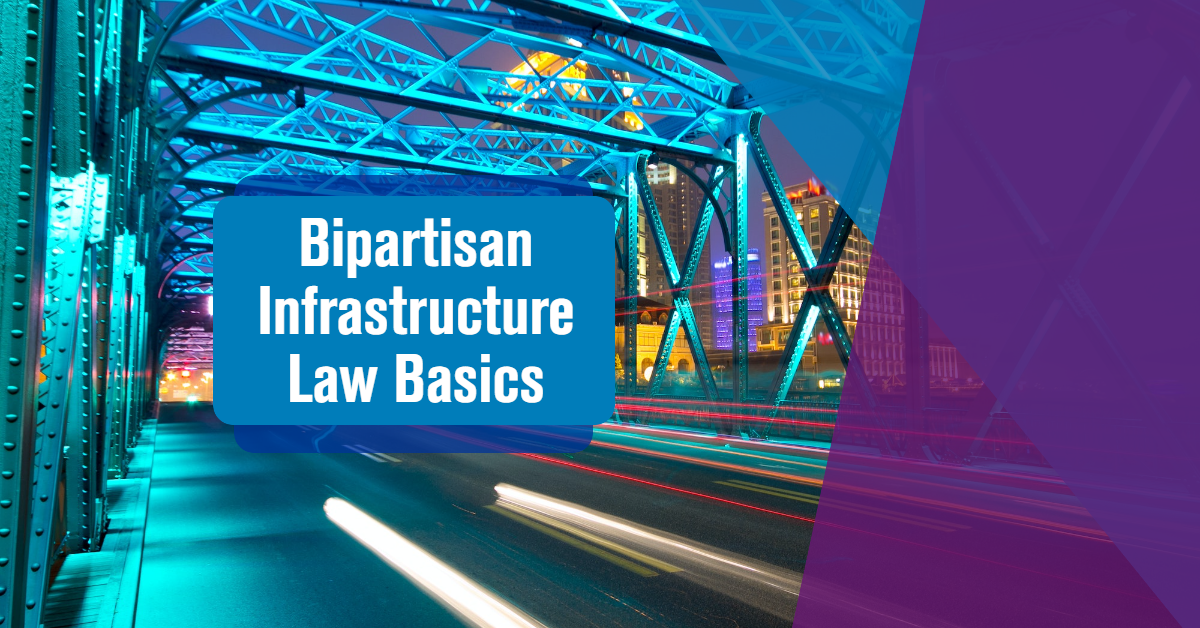The Bipartisan Infrastructure Law is far reaching, devoting $1.2 trillion to fund thousands of projects nationwide. With so many moving parts, it can get complicated quickly, which is why we’re breaking it down to the basics and answering Infrastructure Investment and Jobs Act FAQs.
Names and Acronyms for the Infrastructure Law
The Infrastructure Law often goes by two names and acronyms. These are interchangeable.
- The Bipartisan Infrastructure Law (BIL)
- The Infrastructure Investment and Jobs Act (IIJA)
When Was the Infrastructure Investment and Jobs Act Signed into Law?
The IIJA was enacted by the 117th United States Congress and signed into law by President Biden on November 15, 2021.
What Does “Infrastructure” Refer To?
The Bipartisan Infrastructure Law essentially speaks to two different kinds of infrastructure:
- Traditional Infrastructure: Upgrades to roads, bridges, rail, ports, airports and more.
- Human Infrastructure: Projects that promote clean energy, expand broadband access, provide good paying wages for workers, and buying American-made materials for infrastructure projects.
How Much Funding Does the Infrastructure Law Provide?
The Bipartisan Infrastructure Law authorizes $1.2 trillion for transportation and infrastructure spending. This can be broken down into two types of funding:
- Baseline spending: $650 billion, which represents money the federal government was already planning to spend.
- New infrastructure investment: $550 billion in funding above the baseline for new investments and programs.
Where Is IIJA Money Going?
Infrastructure Investment and Jobs Act funding for new infrastructure investments falls breaks down like this:
- Roads and bridges: $110 billion
- Power and grid: $73 billion
- Passenger and freight rail: $66 billion
- Broadband: $65 billion
- Water infrastructure: $55 billion
- Resiliency: $46 billion
- Transit: $39 billion
- Airports: $25 billion
- Environmental remediation: $21 billion
- Ports and waterways: $17 billion
- Safety: $11 billion
- Low-carbon buses and ferries: $7.5 billion
- EV infrastructure: $7.5 billion
Where Are BIL Funds Allocated and How Much Money Does Each State Get?
The top five largest allocations of funds from the Infrastructure Investment and Jobs Act are:
- California ($44.5 billion)
- Texas ($35.4 billion)
- New York ($26.9 billion)
- Florida ($19.1 billion)
- Illinois ($17.84 billion)
Although states with smaller populations will receive less money, they will get more dollars per capita:
- Wyoming ($2.5 billion)
- Vermont ($2.2 billion)
- Alaska ($4.9 billion)
- North Dakota ($2.6 billion)
- South Dakota ($2.8 billion)
Details on funding for each U.S. state and territory can be found on their individual fact sheets.
How Does Bipartisan Infrastructure Law Funding Impact Businesses?
Infrastructure upgrades will require materials like metals, asphalt, cement, rock, and other construction materials. Although producers of these commodities won’t receive funding directly from the federal government, they are likely to see a spike in demand for their products.
Before this growth happens, companies will want to ensure their supply chain is ready to take on the additional volume.
TIP: Compare your transportation options.
What IIJA Money Has Already Been Spent?
As of October 25, 2022, announced Bipartisan Infrastructure Law funding totaled over $185 billion for 6,900 specific projects that reach 4,000 communities across all 50 states, D.C., and the territories.
More Answers to IIJA/BIL Questions and Expert Insights
To learn additional details about the Bipartisan Infrastructure Law watch our on-demand webinar, “The Impact of the Infrastructure Law on Industrial Markets.” The webinar features insights from federal infrastructure expert Alex Etchen, who decodes the Bipartisan Infrastructure Law and answers more questions like:
- What is the impact of the Bipartisan Infrastructure Law on industrial markets like metals, asphalt, cement, rock, and other constructions materials?
- How quickly will Infrastructure Investment and Jobs Act funding go out the door?
- What Is Build America, Buy America?
- How does inflation impact infrastructure funding?
- How is inflation affecting the construction materials needed to complete these projects?
- How does the first year of IIJA funding compare to subsequent years?
Related Articles
- How Will the Infrastructure Law Impact Industrial Markets?
- How Does the Infrastructure Bill Impact Freight Railroads?
- America’s “Water Highway” Is Aging — Are You Prepared for the Closures Ahead?
- The Impact of America’s Failing Infrastructure on Supply Chains
- Freight Shipping and Its Impact on Climate Change
- Transportation Modes Revealed: A Comprehensive Look










